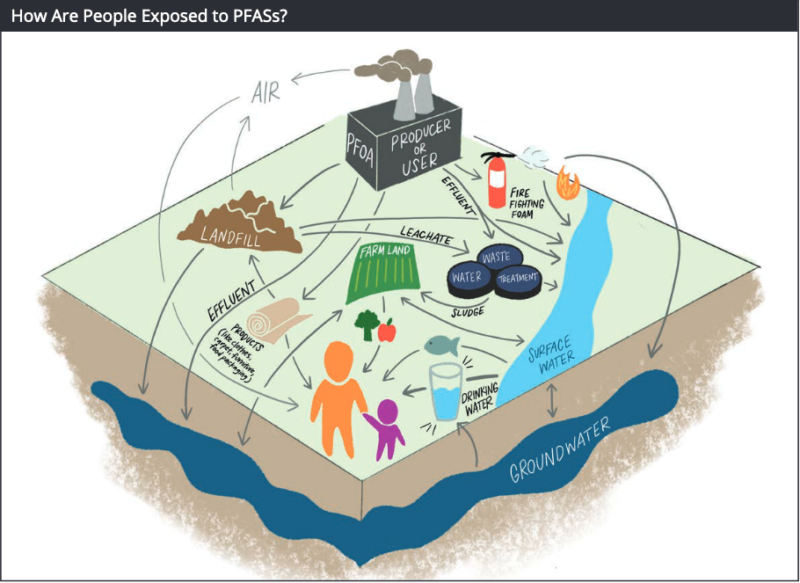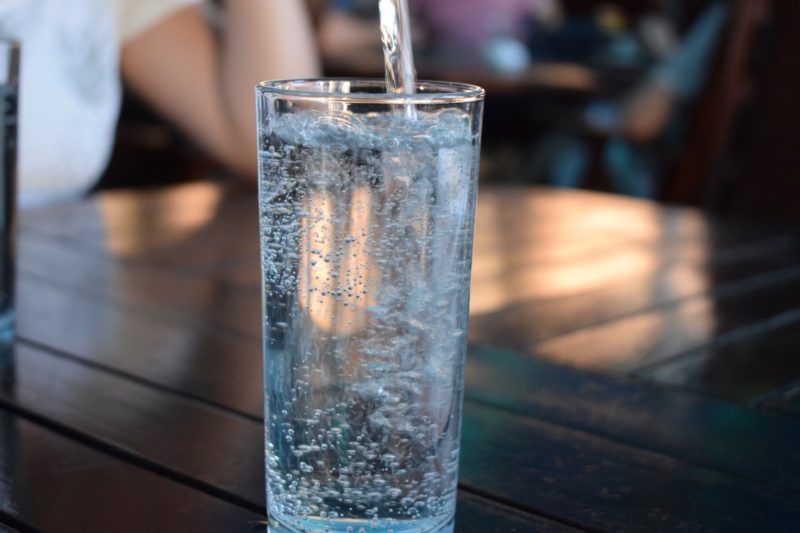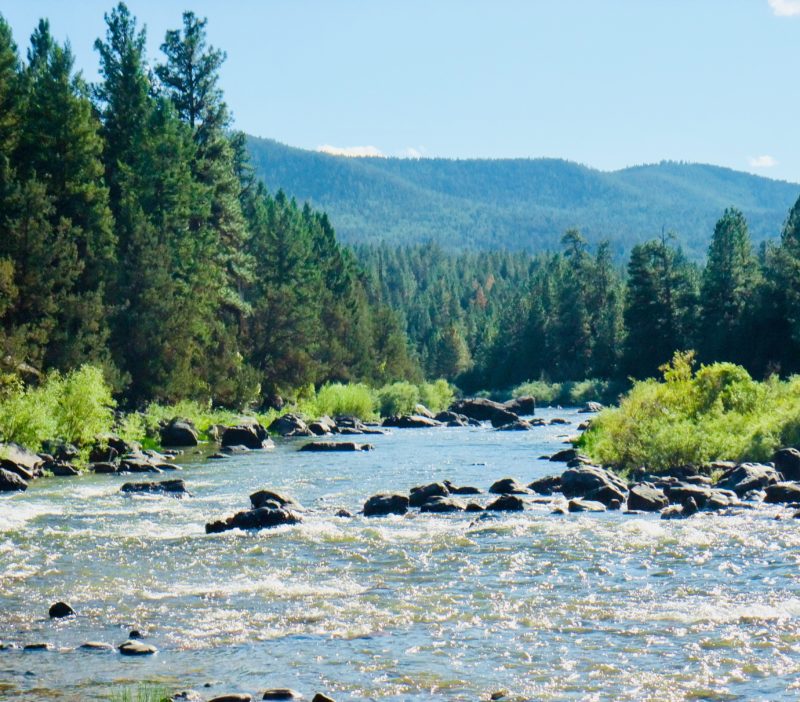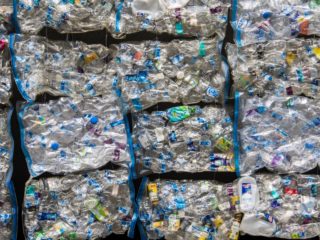Polyfluoroalkyl. Perfluoroalkyl. PFOA, PFAS, PFOA, GenX. Forever Chemicals. You may have seen these terms sprinkled through recent news stories, or even referenced in the new film Dark Waters. What the heck is this all about, and should you be worried?
What are Forever Chemicals?
The term “forever chemicals” is a nickname for a class of manufactured fluorinated chemical substances found in a whole host of consumer products, drinking water, and in industrial practices. Technically known as per- and polyfluorinated compounds, there are nearly 5,000 of these forever chemicals, all grouped into one category, known as PFAS.
The most common and widespread chemicals in the PFAS group are perfluorooctanesulfonic acid (PFOS) and perfluorooctanoic acid (PFOA). Used for their non-stick (PFOA) and cleaning (PFOS) properties, these chemicals are no longer manufactured but have been replaced by other PFAS substances, such as GenX.
They’re called forever chemicals because they last, well, forever, or at least indefinitely in your body and the environment.
Where Can You Find Forever Chemicals?

Where will you find forever chemicals? The short answer: everywhere. The list of products containing PFAS chemicals is endless and pervasive. By no means exhaustive, the broad categories of exposure include food, food packaging, household and personal products, clothing, and contaminated groundwater and drinking water.
Health Effects

Before I get to the health effects, it’s important to remember this: You have PFAS chemicals in your body right now. These chemicals enter your body in numerous ways, from drinking contaminated water, eating contaminated seafood or food packaged with PFAS compounds, to using products that contain PFASs. It’s impossible to avoid exposure.
How our bodies process these chemicals is, of course, an important factor and is the subject of continued study, but the current list of health complications from PFAS exposure is already long, and we should be concerned. In fact, when it comes to PFAS chemicals in our drinking water, some scientists have concluded that there is no safe level of these toxins.
I list below some of the health complications but keep in mind that not every chemical in the PFAS group has been studied, so this list could expand.
- Increased risk of cancer.
- Fertility complications.
- Certain birth defects.
- Interference with the body’s natural hormones.
- Increased cholesterol levels.
- Increased chance of thyroid disease.
- Reduced effectiveness of childhood vaccines.
- Interference with the body’s immune system.
An Unregulated Class of Chemicals

Sadly, our current government regulatory structure is not a reliable safeguard against PFAS contamination. As of today, there is no enforceable regulatory set of standards imposed for this class of chemicals. The Trump administration and its agencies have instead dragged their feet, or even stonewalled attempts to conduct studies and institute consumer protection measures.
In 2018, the White House and EPA attempted to suppress the release of a report by the Centers for Disease Control on PFAS health effects on water contamination near military bases, chemical plants, and other sites. More recently, a new CDC comprehensive study of these chemicals has faced delays and setbacks from the Trump administration. And attempts by Congressional lawmakers to pass protective drinking water standards for PFASs have been met with veto threats by President Trump.
Contrast all this with the progress made by EU governments, which have moved to regulate and restrict the usage of PFASs (as a group), including the recent announcement to phase out these chemicals by 2030.
A bright spot is that some states, including New Jersey, Vermont, and Minnesota, have stepped in to protect their citizens by enacting more rigorous oversight of certain PFAS chemicals.
What Can You Do to Limit Your Exposure?

As I’ve mentioned, our federal government has not provided sufficient consumer protection from PFAS contamination. So what can you do? Take matters into your own hands and empower yourself to protect your body, your community, and your planet.
Educate Yourself
Well done! You’ve reached this point on my post and you’re now that much more knowledgeable about forever chemicals. Don’t stop here! Read far and wide to stay informed. I list a few resources below for further reading.
- Environmental Working Group‘s interactive PFAS Contamination map is the go-to source for a big picture view of the extent of this nation’s exposure to PFAS contamination. While there, browse through their numerous other guides and resources.
- Centers for Disease Control has a PFAS page that is periodically updated.
- Environment & Human Health organization is a non-profit dedicated to protecting human health from environmental harm through research, education, and the promotion of sound public policies. Their daily e-blast will keep you up-to-date.
- Green Science Policy Institute’s scientists, educators and experts translate technical information into understandable material for us all. Check out the website for their extensive resources and the latest PFAS news.
- Northeastern University has a PFAS website that includes timelines and a contamination site tracker.
- Safer States has a handy bill tracker to see what laws your state has passed.
- STEEP, a partnership of the University of Rhode Island, Harvard T.H. Chan School of Public Health, Department of Environmental Health, and Silent Spring Institute, undertakes PFAS research and community engagement. The STEEP site contains extensive resources, including news, videos, presentations, and podcasts.
- Union of Concerned Scientists is always a useful resource. Check out their fact sheet on PFAS contamination at military bases.
Check Your Water and Food
For drinking water at home, consider purchasing a water filtration system to reduce your exposure to toxins. EWG has a handy water filter guide so you know what kind to get. Remember to change the water filter regularly. When you’re out and about, instead of bottled water, purchase a reusable glass or stainless steel bottle.
For food, control what goes into your body by preparing meals from minimally processed ingredients instead of purchasing pre-packaged meals.
Check Your Products: Consumer Guides
Be a savvy consumer and consult reputable consumer guides to avoid PFAS-containing products. You won’t be able to eliminate PFAS exposure but you’ll be able to minimize it.
- Cradle 2 Cradle Certified Organization includes a wide variety of consumer products and brands that have qualified for the organization’s rigorous environmental and safe certification standards.
- Environmental Working Group‘s personal care database is indispensable.
- Made Safe also has a guide for safe, toxin-free products.
- PFAS Central updates its PFAS-Free Products list on a regular basis.
Stay Current
Now that you know what forever chemicals are it’s important to keep an eye out for news and updates. We can’t rely on the current federal regulatory system to inform and protect us, so the key is to continuously check reliable sources for the latest news.
Take Action
Does this issue have you infuriated, freaked out, or feeling helpless? Or all of the above? Get involved! It can be as simple as signing a petition advocating for more stringent standards, joining an advocacy organization, and/or voting for candidates who campaign for regulatory change.
If you’re really fired up, start a group in your community to put pressure on local and state legislators. I did (for reusable bag legislation), and you can too! The point is to stay engaged with these critical environmental policy issues so you can be part of making that change.









